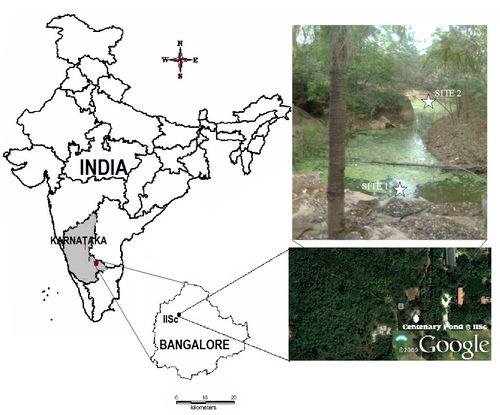|
MATERIALS AND METHODS
Study Area: Centenary Pond (Figure 1) is located at Indian Institute of Science (IISc) Bangalore, Karnataka. The pond (130.01’16.78” N and 770 34’ 14.96” E) was created in April 2008 in the Jubilee Garden at Indian Institute of Science (IISc, Bangalore) in order to harvest rain water and provide habitat for aquatic flora and fauna.
Water Sample Collection: Water samples were collected from two different sites (S1 and S2) for a period of five months from February 2012 to June 2012 for the analysis of physico-chemical parameters and phytoplankton identification. The Site 1(S1; Inflow end) and Site 2 (S2; rear end) were considered for sampling in the Centenary pond between 10.00 to 12.00 a.m.
Algal Sampling, Identification and Enumeration: Phytoplankton samples were collected from the surface water at S1and S2. Algae were identified and counted microscopically. 100 ml of sample were collected from the selected locations. 15 ml samples were taken and were centrifuged at 3000 rpm at room temperature. From the concentrate, ~20 µl of the sample were taken onto glass slide and were counted and enumerated under light microscope (40 X) following drop count method (Trivedy and Goel, 1986). Representative images were taken at 100 X magnification. The identification of algal species was carried out based on the morphological features, according to Prescott (1959), Desikachary (1959).
Analysis of Physico-Chemical Parameters : The water temperature, pH, electrical conductivity and DO were determined on site at the time of sampling. Other parameters like ammonia, nitrate, nitrite, orthophosphate, total phosphate, optical density, total alkalinity, calcium and magnesium hardness, total hardness, chlorides, chemical oxygen demand (COD), biochemical oxygen demand (BOD), sodium and potassium were analysed using standard methods prescribed by Trivedi and Goel (1986), APHA (1998) and following Hach Protocols.

Figure 1: Centenary Pond in Jubilee Garden, IISc Bangalore, Karnataka India
|


